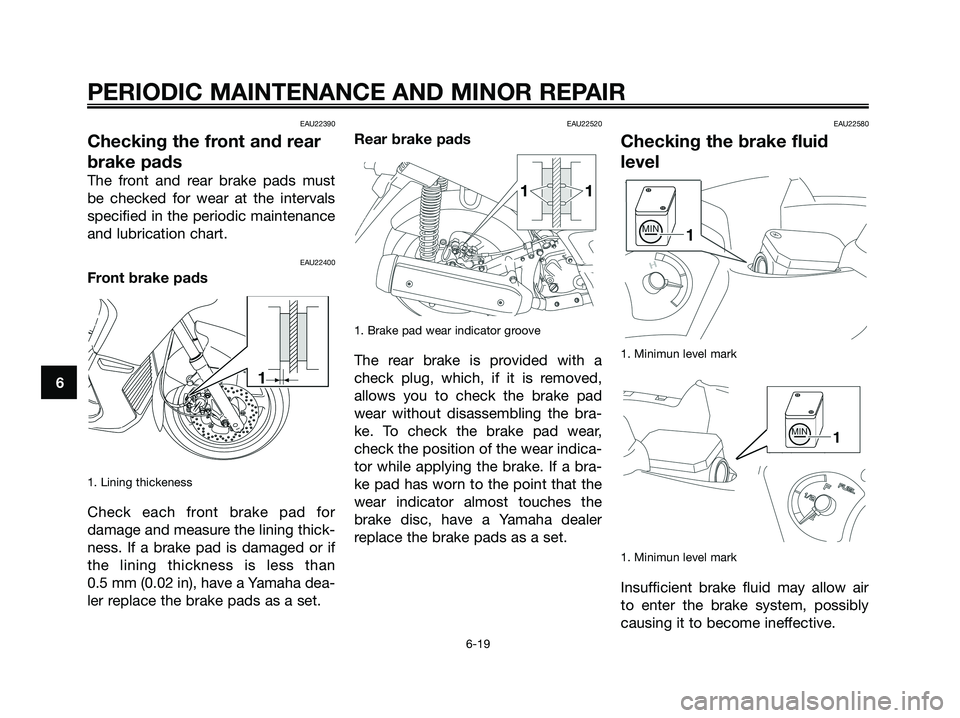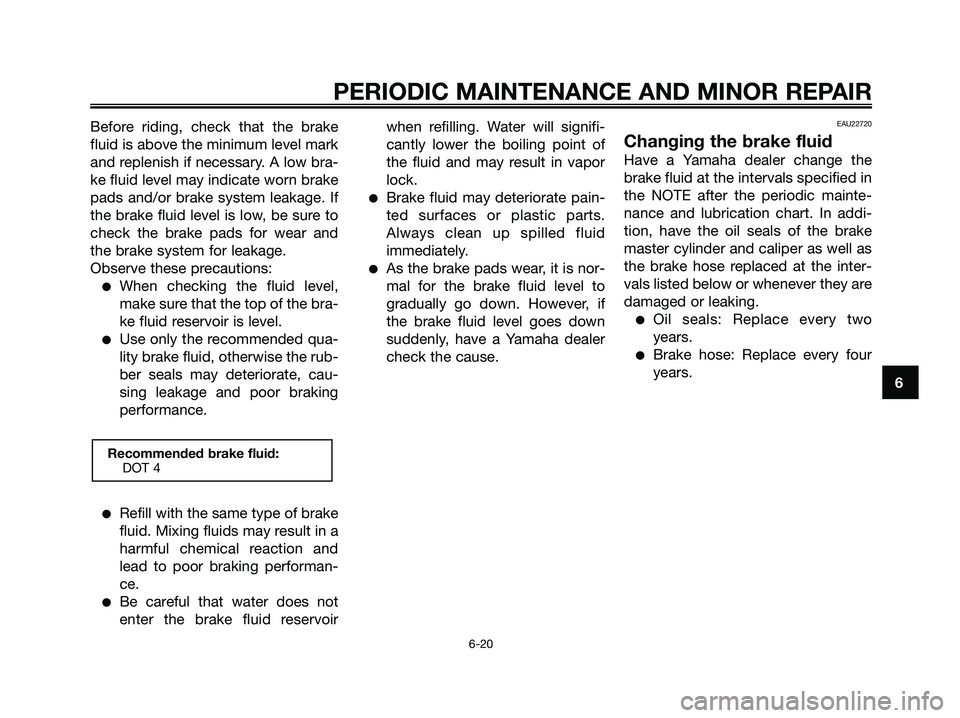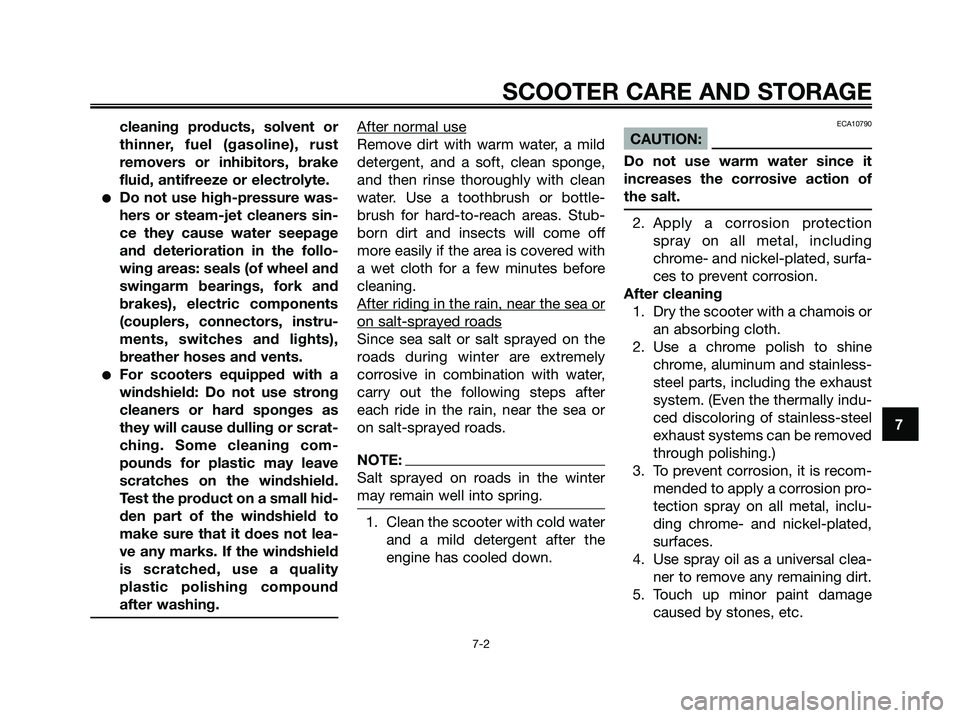Page 59 of 88

EAU21960
Cast wheels
To maximize the performance, durabi-
lity, and safe operation of your vehi-
cle, note the following points regar-
ding the specified wheels.
●The wheel rims should be chec-
ked for cracks, bends or warpage
before each ride. If any damage
is found, have a Yamaha dealer
replace the wheel. Do not
attempt even the smallest repair
to the wheel. A deformed or crac-
ked wheel must be replaced.
●The wheel should be balanced
whenever either the tire or wheel
has been changed or replaced.
An unbalanced wheel can result
in poor performance, adverse
handling characteristics, and a
shortened tire life.
●Ride at moderate speeds after
changing a tire since the tire sur-
face must first be “broken in” for
it to develop its optimal characte-
ristics.
EAU33453
Front and rear brake lever
free play
Front
Rear
There should be no free play at the
brake lever ends. If there is free play,
have a Yamaha dealer inspect the
brake system.
EWA14211
s s
WARNING
A soft or spongy feeling in the bra-
ke lever can indicate the presence
of air in the hydraulic system. If the-
re is air in the hydraulic system,
have a Yamaha dealer bleed the
system before operating the vehi-
cle. Air in the hydraulic system will
diminish the braking performance,
which may result in loss of control
and an accident.
PERIODIC MAINTENANCE AND MINOR REPAIR
6-18
6
1C0-F8199-E4.qxd 22/11/07 05:41 Página 59
Page 60 of 88

EAU22390
Checking the front and rear
brake pads
The front and rear brake pads must
be checked for wear at the intervals
specified in the periodic maintenance
and lubrication chart.
EAU22400
Front brake pads
1. Lining thickeness
Check each front brake pad for
damage and measure the lining thick-
ness. If a brake pad is damaged or if
the lining thickness is less than
0.5 mm (0.02 in), have a Yamaha dea-
ler replace the brake pads as a set.
EAU22520
Rear brake pads
1. Brake pad wear indicator groove
The rear brake is provided with a
check plug, which, if it is removed,
allows you to check the brake pad
wear without disassembling the bra-
ke. To check the brake pad wear,
check the position of the wear indica-
tor while applying the brake. If a bra-
ke pad has worn to the point that the
wear indicator almost touches the
brake disc, have a Yamaha dealer
replace the brake pads as a set.
EAU22580
Checking the brake fluid
level
1. Minimun level mark
1. Minimun level mark
Insufficient brake fluid may allow air
to enter the brake system, possibly
causing it to become ineffective.
PERIODIC MAINTENANCE AND MINOR REPAIR
6-19
6
1C0-F8199-E4.qxd 22/11/07 05:41 Página 60
Page 61 of 88

Before riding, check that the brake
fluid is above the minimum level mark
and replenish if necessary. A low bra-
ke fluid level may indicate worn brake
pads and/or brake system leakage. If
the brake fluid level is low, be sure to
check the brake pads for wear and
the brake system for leakage.
Observe these precautions:
●When checking the fluid level,
make sure that the top of the bra-
ke fluid reservoir is level.
●Use only the recommended qua-
lity brake fluid, otherwise the rub-
ber seals may deteriorate, cau-
sing leakage and poor braking
performance.
●Refill with the same type of brake
fluid. Mixing fluids may result in a
harmful chemical reaction and
lead to poor braking performan-
ce.
●Be careful that water does not
enter the brake fluid reservoirwhen refilling. Water will signifi-
cantly lower the boiling point of
the fluid and may result in vapor
lock.
●Brake fluid may deteriorate pain-
ted surfaces or plastic parts.
Always clean up spilled fluid
immediately.
●As the brake pads wear, it is nor-
mal for the brake fluid level to
gradually go down. However, if
the brake fluid level goes down
suddenly, have a Yamaha dealer
check the cause.
EAU22720
Changing the brake fluid
Have a Yamaha dealer change the
brake fluid at the intervals specified in
the NOTE after the periodic mainte-
nance and lubrication chart. In addi-
tion, have the oil seals of the brake
master cylinder and caliper as well as
the brake hose replaced at the inter-
vals listed below or whenever they are
damaged or leaking.
●Oil seals: Replace every two
years.
●Brake hose: Replace every four
years.
Recommended brake fluid:
DOT 4
PERIODIC MAINTENANCE AND MINOR REPAIR
6-20
6
1C0-F8199-E4.qxd 22/11/07 05:41 Página 61
Page 62 of 88

EAU23100
Checking and lubricating the
cables
The operation of all control cables
and the condition of the cables
should be checked before each ride,
and the cables and cable ends should
be lubricated if necessary. If a cable is
damaged or does not move smoothly,
have a Yamaha dealer check or repla-
ce it.
EWA10720
s s
WARNING
Damage to the outer sheath may
interfere with proper cable opera-
tion and will cause the inner cable
to rust. Replace a damaged cable
as soon as possible to prevent
unsafe conditions.
EAU23111
Checking and lubricating the
throttle grip and cable
The operation of the throttle grip
should be checked before each ride.
In addition, the cable should be lubri-
cated at the intervals specified in the
periodic maintenance chart.
EAU23171
Lubricating the front and
rear brake levers
The pivoting points of the front and
rear brake levers must be lubricated
at the intervals specified in the perio-
dic maintenance and lubrication chart.
Recommended lubricant:
Lithium-soap-based grease (all-
purpose grease)
ZAUM0061
Recommended lubricant:
Engine oil
PERIODIC MAINTENANCE AND MINOR REPAIR
6-21
6
1C0-F8199-E4.qxd 22/11/07 05:41 Página 62
Page 64 of 88
2. While applying the front brake,
push down hard on the handle-
bars several times to check if the
front fork compresses and
rebounds smoothly.
ECA10590
CAUTION:
If any damage is found or the front
fork does not operate smoothly,
have a Yamaha dealer check or
repair it.
EAU23280
Checking the steering
Worn or loose steering bearings may
cause danger. Therefore, the opera-
tion of the steering must be checked
as follows at the intervals specified in
the periodic maintenance and lubrica-
tion chart.
1. Place a stand under the engine to
raise the front wheel off the
ground.
EWA10750
s s
WARNING
Securely support the vehicle so
that there is no danger of it falling
over.
2. Hold the lower ends of the front
fork legs and try to move them
forward and backward. If any free
play can be felt, have a Yamaha
dealer check or repair the stee-
ring.
PERIODIC MAINTENANCE AND MINOR REPAIR
6-23
6
1C0-F8199-E4.qxd 22/11/07 05:41 Página 64
Page 69 of 88

●Headlight lens
• Do not affix any type of tinted
film or stickers to the head-
light lens.
• Do not use a headlight bulb
of a wattage higher than spe-
cified.
5. Install the headlight bulb cover,
and then connect the coupler.
6. Install the cowling.
7. Have a Yamaha dealer adjust the
headlight beam if necessary.
EAU24240
Replacing a front turn signal
light bulb
1. Place the scooter on the centers-
tand.
2. Remove cowling A. (See page
6-6.)
3. Remove the socket (together
with the turn signal light bulb) by
turning it counterclockwise.
1. Turn signal light bulb socket
4. Remove the defective bulb by
pushing it in and turning it coun-
terclockwise.
5. Insert a new bulb into the socket,
push it in, and then turn it clock-
wise until it stops.
6. Install the socket (together with
the bulb) by turning it clockwise.
7. Install the cowling.
EAUS1440
Replacing a tail/brake light
bulb or a rear turn signal
light bulb
1. Place the scooter on the centers-
tand.
2. Open the seat, and then remove
the rear storage compartment.
(See page 3-16.)
1. Rear storage compartment
2. Bolt
3. Remove the tail/brake light and
turn signal light bulb holder by
pulling it outward.
PERIODIC MAINTENANCE AND MINOR REPAIR
6-28
6
1C0-F8199-E4.qxd 22/11/07 05:41 Página 69
Page 70 of 88
1. Bulb socket
1. Push.1. Remove
4. Remove the defective bulb by
pushing it in and turning it coun-
terclockwise.
1. Turn signal light bulb
2. Tail/brake light bulb
5. Insert a new bulb into the socket
by pushing it in and turning it
clockwise.6. Install the bulb holder by pushing
it into the original position.
7. Install the rear storage compart-
ment, and then close the seat.
PERIODIC MAINTENANCE AND MINOR REPAIR
6-29
6
1C0-F8199-E4.qxd 22/11/07 05:41 Página 70
Page 75 of 88

cleaning products, solvent or
thinner, fuel (gasoline), rust
removers or inhibitors, brake
fluid, antifreeze or electrolyte.
●Do not use high-pressure was-
hers or steam-jet cleaners sin-
ce they cause water seepage
and deterioration in the follo-
wing areas: seals (of wheel and
swingarm bearings, fork and
brakes), electric components
(couplers, connectors, instru-
ments, switches and lights),
breather hoses and vents.
●For scooters equipped with a
windshield: Do not use strong
cleaners or hard sponges as
they will cause dulling or scrat-
ching. Some cleaning com-
pounds for plastic may leave
scratches on the windshield.
Test the product on a small hid-
den part of the windshield to
make sure that it does not lea-
ve any marks. If the windshield
is scratched, use a quality
plastic polishing compound
after washing.
After normal use
Remove dirt with warm water, a mild
detergent, and a soft, clean sponge,
and then rinse thoroughly with clean
water. Use a toothbrush or bottle-
brush for hard-to-reach areas. Stub-
born dirt and insects will come off
more easily if the area is covered with
a wet cloth for a few minutes before
cleaning.
After riding in the rain, near the sea or
on salt-sprayed roads
Since sea salt or salt sprayed on the
roads during winter are extremely
corrosive in combination with water,
carry out the following steps after
each ride in the rain, near the sea or
on salt-sprayed roads.
NOTE:
Salt sprayed on roads in the winter
may remain well into spring.
1. Clean the scooter with cold water
and a mild detergent after the
engine has cooled down.
ECA10790
CAUTION:
Do not use warm water since it
increases the corrosive action of
the salt.
2. Apply a corrosion protection
spray on all metal, including
chrome- and nickel-plated, surfa-
ces to prevent corrosion.
After cleaning
1. Dry the scooter with a chamois or
an absorbing cloth.
2. Use a chrome polish to shine
chrome, aluminum and stainless-
steel parts, including the exhaust
system. (Even the thermally indu-
ced discoloring of stainless-steel
exhaust systems can be removed
through polishing.)
3. To prevent corrosion, it is recom-
mended to apply a corrosion pro-
tection spray on all metal, inclu-
ding chrome- and nickel-plated,
surfaces.
4. Use spray oil as a universal clea-
ner to remove any remaining dirt.
5. Touch up minor paint damage
caused by stones, etc.
SCOOTER CARE AND STORAGE
7-2
7
1C0-F8199-E4.qxd 22/11/07 05:41 Página 75